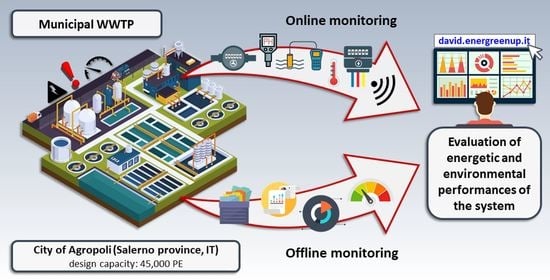Real-Time Monitoring and Static Data Analysis to Assess Energetic and Environmental Performances in the Wastewater Sector: A Case Study
Abstract
:1. Introduction
2. Materials and Methods
2.1. Analysis of Offline Data (Static Monitoring)
2.2. Analysis of Real-Time Data (Dynamic Monitoring)
Statistical Analysis of Real-Time Data
3. Results and Discussion
3.1. Static Monitoring
3.2. Dynamic Monitoring
4. Conclusions
Author Contributions
Funding
Data Availability Statement
Acknowledgments
Conflicts of Interest
References
- Cardoso, B.J.; Rodrigues, E.; Gaspar, A.R.; Gomes, Á. Energy performance factors in wastewater treatment plants: A review. J. Clean. Prod. 2021, 129107. [Google Scholar] [CrossRef]
- Longo, S.; Chitnis, M.; Mauricio-Iglesias, M.; Hospido, A. Transient and Persistent Energy Efficiency in the Wastewater Sector based on Economic Foundations. Energy J. 2020, 41. [Google Scholar] [CrossRef]
- Gehring, T.; Deineko, E.; Hobus, I.; Kolisch, G.; Lübken, M.; Wichern, M. Effect of sewage sampling frequency on determination of design parameters for municipal wastewater treatment plants. Water Sci. Technol. 2020, 84, 284–292. [Google Scholar] [CrossRef]
- Daelman, M.R.J.; De Baets, B.; van Loosdrecht, M.C.M.; Volcke, E.I.P. Influence of sampling strategies on the estimated nitrous oxide emission from wastewater treatment plants. Water Res. 2013, 47, 3120–3130. [Google Scholar] [CrossRef]
- Li, Z.; Zou, Z.; Wang, L. Analysis and Forecasting of the Energy Consumption in Wastewater Treatment Plant. Math. Probl. Eng. 2019, 2019, 1–8. [Google Scholar] [CrossRef] [Green Version]
- IEA. World Energy Outlook; Organisation for Economic Co-Operation and Development/International Energy Agency: Paris, France, 2016. [Google Scholar]
- Utilitalia. Linea Guida per l’Esecuzione della Diagnosi Energetica ai Sensi Dell’articolo 8 del d.lgs 102/2014—Servizio Idrico Integrato. Transl. “Guideline for the Execution of the Energy Diagnosis according to Article 8 of the Legislative Decree No. 102/2014—Integrated Water Service”; Utilitalia—Imprese Acqua Ambiente Energia: Rome, Italy, 2018. [Google Scholar]
- Metcalf&Eddy. Wastewater Engineering, Treatment and Reuse, 4th ed.; McGraw Hill: New York, NY, USA, 2014. [Google Scholar]
- Kehrein, P.; van Loosdrecht, M.; Osseweijer, P.; Garfí, M.; Dewulf, J.; Posada, J. A critical review of resource recovery from municipal wastewater treatment plants—Market supply potentials, technologies and bottlenecks. Environ. Sci. Water Res. Technol. 2020, 6, 877–910. [Google Scholar] [CrossRef] [Green Version]
- Capodaglio, A.G.; Olsson, G. Energy issues in sustainable urban wastewater management: Use, demand reduction and recovery in the urban water cycle. Sustainability 2020, 12, 266. [Google Scholar] [CrossRef] [Green Version]
- PNRR. Piano Nazionale di Ripresa e Resilienza (IT). Transl: National Recovery and Resilience Plan (Italy). In Next Generation EU Program; Ministero dell’Economia e delle Finanze: Rome, Italy, 2021. Available online: https://www.governo.it/sites/governo.it/files/PNRR.pdf (accessed on 29 September 2021).
- Bhatia, S.K.; Mehariya, S.; Bhatia, R.K.; Kumar, M.; Pugazhendhi, A.; Awasthi, M.K.; Atabani, A.E.; Kumar, G.; Kim, W.; Seo, S.-O.; et al. Wastewater based microalgal biorefinery for bioenergy production: Progress and challenges. Sci. Total Environ. 2021, 751, 141599. [Google Scholar] [CrossRef] [PubMed]
- Goswami, R.K.; Mehariya, S.; Verma, P.; Lavecchia, R.; Zuorro, A. Microalgae-based biorefineries for sustainable resource recovery from wastewater. J. Water Process. Eng. 2020, 101747. [Google Scholar] [CrossRef]
- di Cicco, M.R.; Palmieri, M.; Altieri, S.; Ciniglia, C.; Lubritto, C. Cultivation of the Acidophilic Microalgae Galdieria phlegrea with Wastewater: Process Yields. Int. J. Environ. Res. Public Health 2021, 18, 2291. [Google Scholar] [CrossRef]
- Foladori, P.; Vaccari, M.; Vitali, F. Energy audit in small wastewater treatment plants: Methodology, energy consumption indicators, and lessons learned. Water Sci. Technol. 2015, 72, 1007–1015. [Google Scholar] [CrossRef] [Green Version]
- Vetromile, C.; Spagnuolo, A.; Petraglia, A.; Masiello, A.; di Cicco, M.R.; Lubritto, C. Pre- and post-operam comparison of the energy consumption of a radio base station under energy efficiency actions. Energy Build. 2021, 236, 110772. [Google Scholar] [CrossRef]
- Mamandipoor, B.; Majd, M.; Sheikhalishahi, S.; Modena, C.; Osmani, V. Monitoring and detecting faults in wastewater treatment plants using deep learning. Environ. Monit. Assess. 2020, 192, 148. [Google Scholar] [CrossRef]
- di Cicco, M.R.; Spagnuolo, A.; Masiello, A.; Vetromile, C.; Nappa, M.; Corbo, G.; Lubritto, C. Assessing energy performance and critical issues of a large wastewater treatment plant through full-scale data benchmarking. Water Sci. Technol. 2019, 80, 1421–1429. [Google Scholar] [CrossRef]
- D.Lgs 102/2014 as Amended. Legislative Decree no. 102 of 4 July 2014. “Implementation of Directive 2012/27/EU on Energy Efficiency, Amending Directives 2009/125/EC and 2010/30/EU and Repealing Directives 2004/8/EC and 2006/32/EC. (14G00113)”; Official Journal; Istituto Poligrafico e Zecca dello Stato: Rome, Italy, 4 July 2014.
- Fighir, D.; Teodosiu, C.; Fiore, S. Environmental and Energy Assessment of Municipal Wastewater Treatment Plants in Italy and Romania: A Comparative Study. Water 2019, 11, 1611. [Google Scholar] [CrossRef] [Green Version]
- di Cicco, M.R.; Spagnuolo, A.; Masiello, A.; Vetromile, C.; Nappa, M.; Lubritto, C. Energetic and environmental analysis of a wastewater treatment plant through static and dynamic monitoring activities. Int. J. Environ. Sci. Technol. 2020, 17, 4299–4312. [Google Scholar] [CrossRef]
- D.Lgs 152/2006 as Amended. Legislative Decree 152 of 3 April 2006. “Environmental Regulations”; Official Journal; Istituto Poligrafico e Zecca dello Stato: Rome, Italy, 3 April 2006.
- di Cicco, M.R.; Spagnuolo, A.; Masiello, A.; Vetromile, C.; Nappa, M.; Corbo, G.; Lubritto, C. Energy Monitoring of a Wastewater Treatment Plant in Salerno, Campania Region (Southern Italy). In Frontiers in Water-Energy-Nexus—Nature-Based Solutions, Advanced Technologies and Best Practices for Environmental Sustainability; Springer: Cham, Switzerland, 2019. [Google Scholar]
- Longo, S.; d’Antoni, B.M.; Bongards, M.; Chaparro, A.; Cronrath, A.; Fatone, F.; Lema, J.M.; Mauricio-Iglesias, M.; Soares, A.; Hospido, A. Monitoring and diagnosis of energy consumption in wastewater treatment plants. A state of the art and proposals for improvement. Appl. Energy 2016, 179, 1251–1268. [Google Scholar] [CrossRef] [Green Version]
- Abdallaa, K.Z.; Hammamb, G. Correlation between Biochemical Oxygen Demand and Chemical Oxygen Demand for Various Wastewater Treatment Plants in Egypt to Obtain the Biodegradability Indices. Int. J. Sci. Basic Appl. Res. 2014, 13, 42–48. [Google Scholar]
- Papadopoulos, A.; Parissopoulos, G.; Papadopoulos, F.; Karteris, A. Variations of COD/BOD5 ratio at different units of a wastewater stabilization pond pilot treatment facility. In Proceedings of the 7th International Conference on Environmental Science and Technology Ermoupolis, Syros Island, Greece, 3–6 September 2001; pp. 16–19. [Google Scholar]
- Campanelli, M.; Foladori, P.; Vaccari, M. Electricity Consumption and Energy Efficiency in Wastewater Treatment; Maggioli Editore: Rimini, Italy, 2013. [Google Scholar]
- Dias, D.F.C.; Marques, R.; Martins, C.; Martins, A.; Oehmen, A. The impact of a seasonal change in loading rate on the nitrous oxide emissions at the WWTP of a tourist region. Sci. Total Environ. 2022, 804, 149987. [Google Scholar] [CrossRef]
- Bakar, N.A.; Rosbi, S. Effect of Coronavirus disease (COVID-19) to tourism industry. Int. J. Adv. Eng. Res. Sci. 2020, 7, 189–193. [Google Scholar] [CrossRef] [Green Version]
- Cahoon, L.B.; Hanke, M.H. Rainfall effects on inflow and infiltration in wastewater treatment systems in a coastal plain region. Water Sci. Technol. 2017, 75, 1909–1921. [Google Scholar] [CrossRef]
- Vaccari, M.; Foladori, P.; Nembrini, S.; Vitali, F. Benchmarking of energy consumption in municipal wastewater treatment plants—A survey of over 200 plants in Italy. Water Sci. Technol. 2018, 77, 2242–2252. [Google Scholar] [CrossRef] [PubMed]
- Kaloudas, D.; Pavlova, N.; Penchovsky, R. Phycoremediation of wastewater by microalgae: A review. Environ. Chem. Lett. 2021, 2905–2920. [Google Scholar] [CrossRef]
- van Dijk, K.C.; Lesschen, J.P.; Oenema, O. Phosphorus flows and balances of the European Union Member States. Sci. Total Environ. 2016, 542, 1078–1093. [Google Scholar] [CrossRef] [PubMed]
- Egle, L.; Rechberger, H.; Krampe, J.; Zessner, M. Phosphorus recovery from municipal wastewater: An integrated comparative technological, environmental and economic assessment of P recovery technologies. Sci. Total Environ. 2016, 571, 522–542. [Google Scholar] [CrossRef] [Green Version]
- Panda, S.; Mishra, S.; Akcil, A.; Kucuker, M.A. Microalgal potential for nutrient-energy-wastewater nexus: Innovations, current trends and future directions. Energy Environ. 2020, 32, 604–634. [Google Scholar] [CrossRef]
- Čížková, M.; Vítová, M.; Zachleder, V. The Red Microalga Galdieria as a Promising Organism for Applications in Biotechnology. In Microalgae—From Physiology to Application; IntechOpen: London, UK, 2019; Available online: https://www.intechopen.com/chapters/69487 (accessed on 29 September 2021).
- Bottone, C.; Camerlingo, R.; Miceli, R.; Salbitani, G.; Sessa, G.; Pirozzi, G.; Carfagna, S. Antioxidant and anti-proliferative properties of extracts from heterotrophic cultures of Galdieria sulphuraria. Nat. Prod. Res. 2019, 33, 1659–1663. [Google Scholar] [CrossRef] [PubMed]
- López, G.; Yate, C.; Ramos, F.A.; Cala, M.P.; Restrepo, S.; Baena, S. Production of Polyunsaturated Fatty Acids and Lipids from Autotrophic, Mixotrophic and Heterotrophic cultivation of Galdieria sp. strain USBA-GBX-832. Sci. Rep. 2019, 9, 10791. [Google Scholar] [CrossRef] [PubMed]
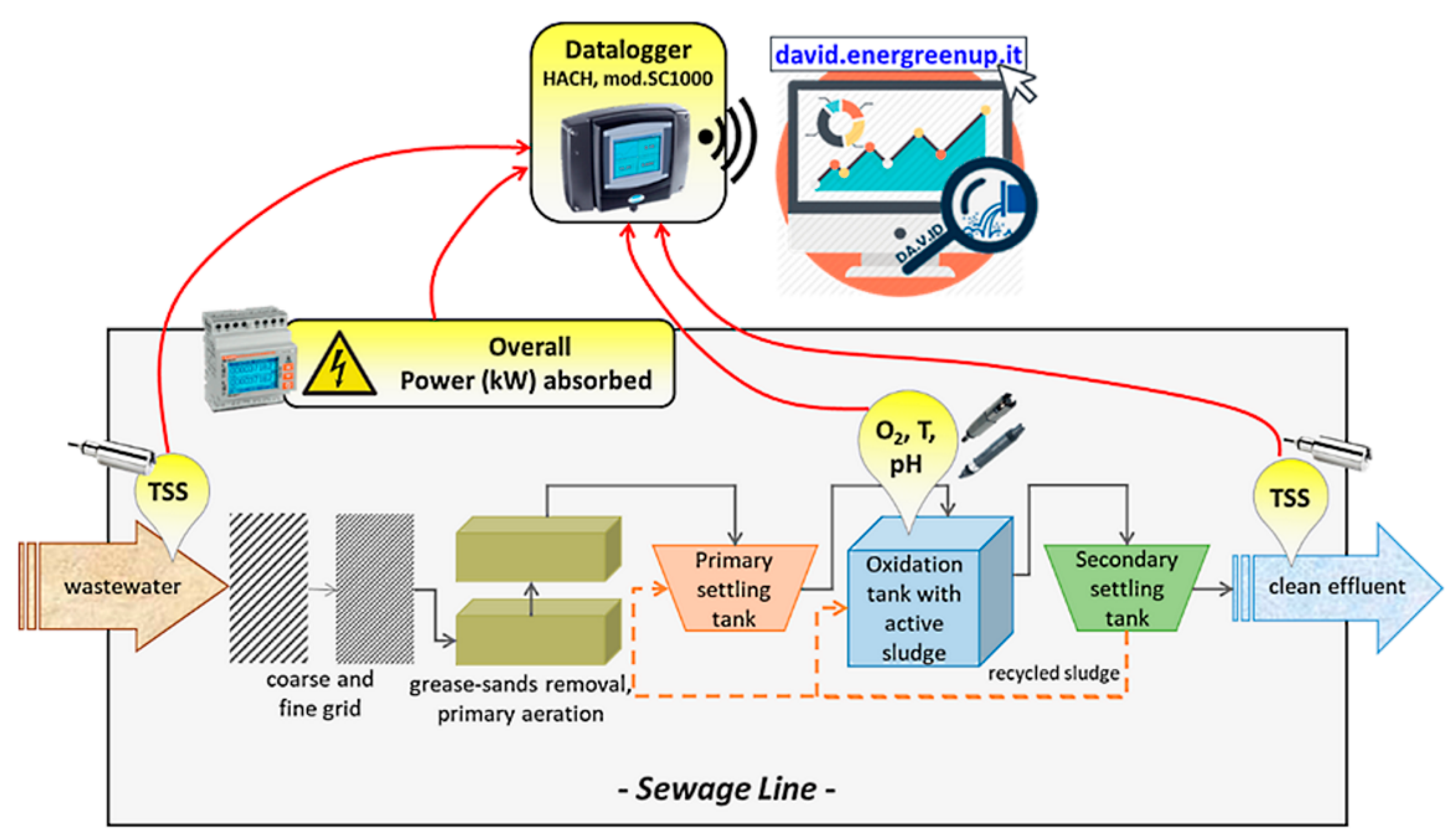
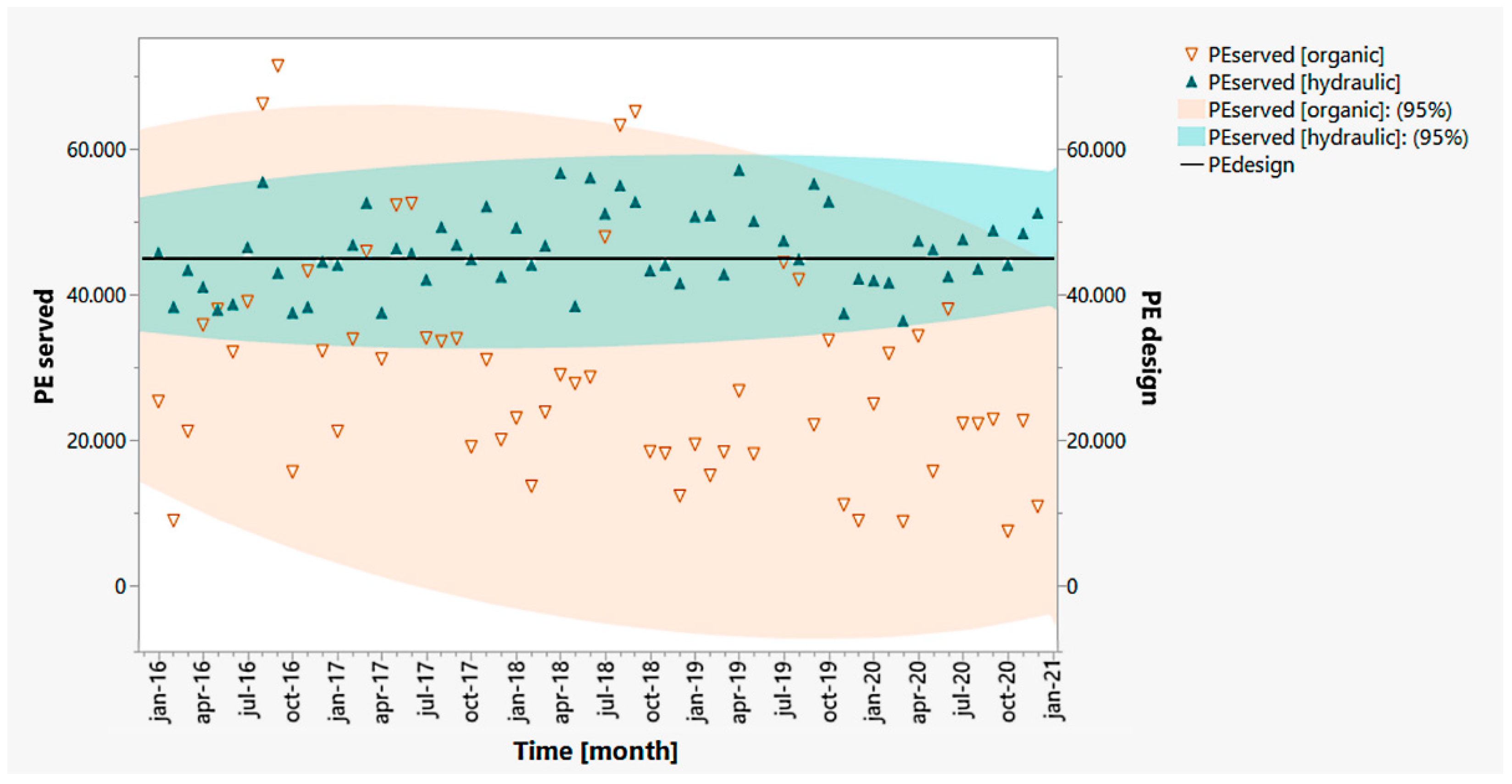
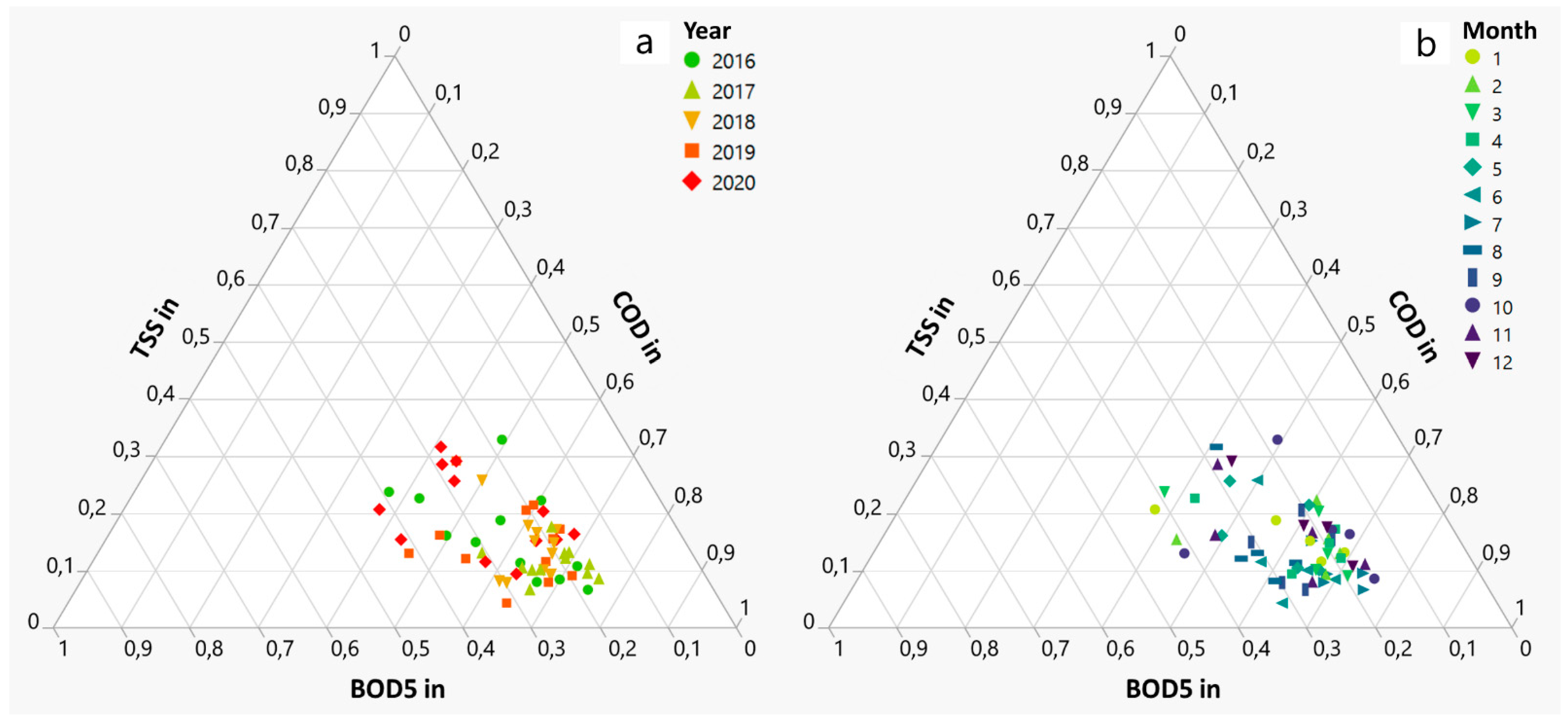


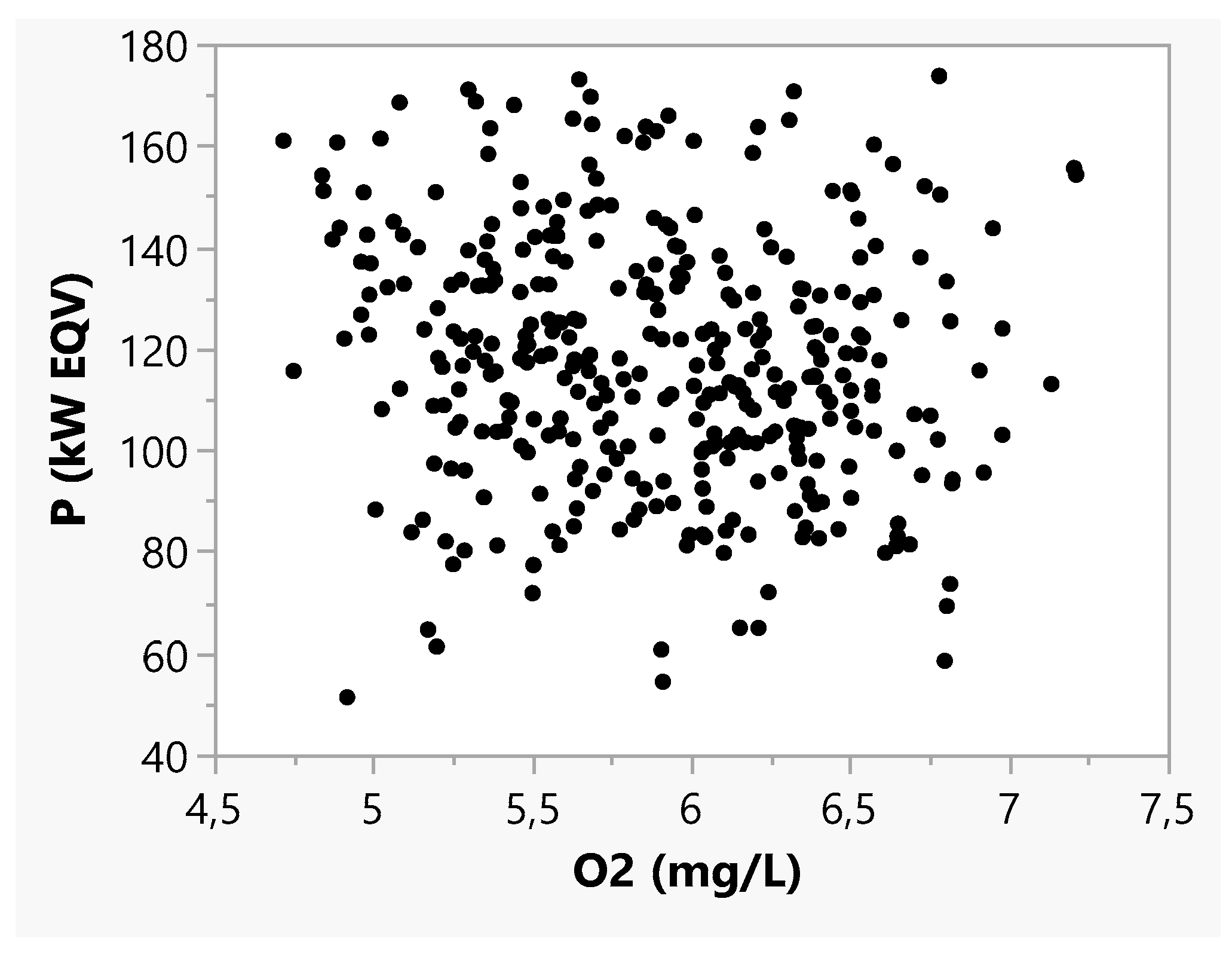
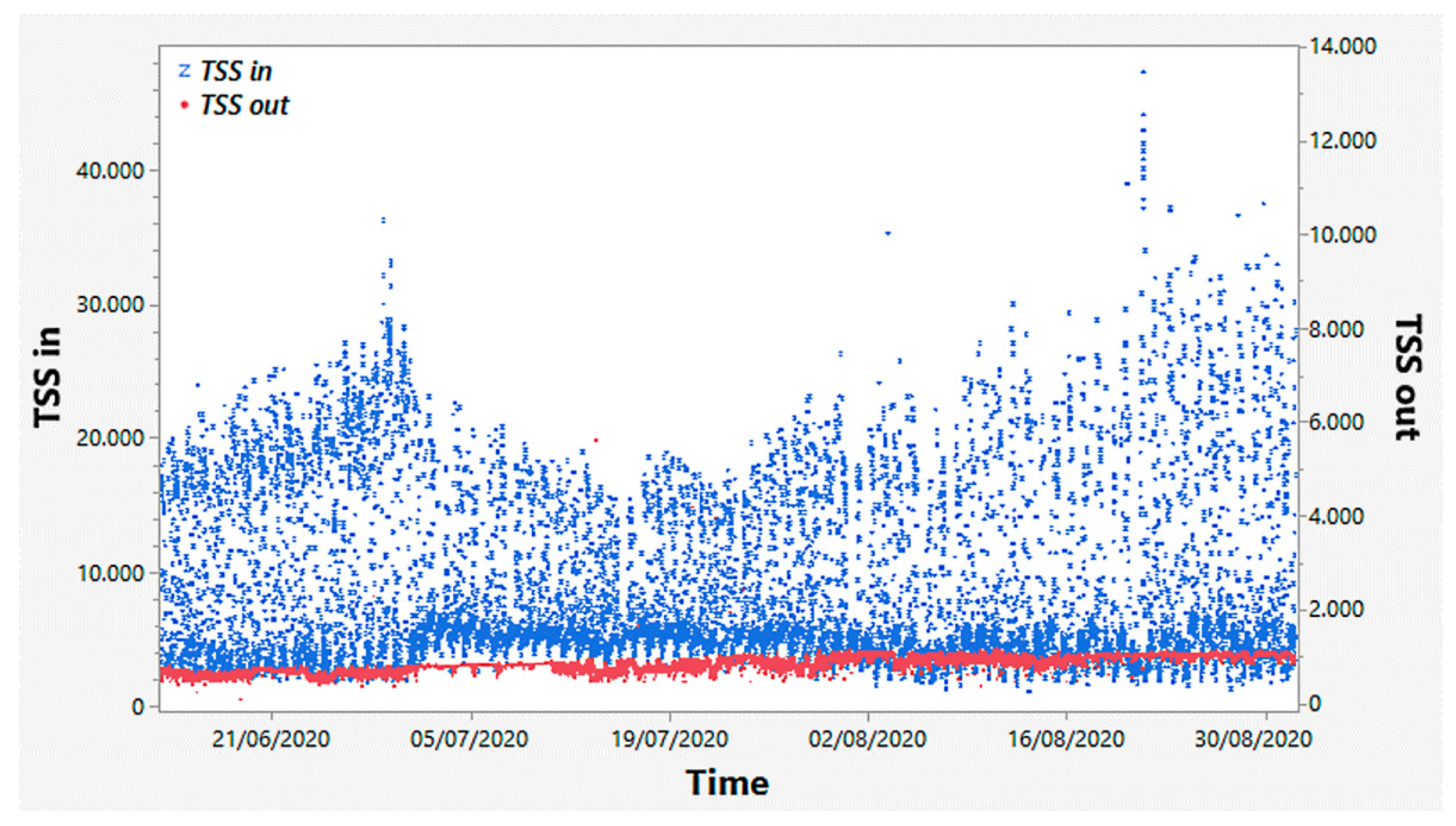
| Indicator (Unit) | Formula |
|---|---|
| (PE) | |
| (PE) | |
| (%) | |
| (%) | |
| (L PE−1 day−1) | |
| (adimensional) | |
| (kWh m−3) | |
| (kWh PE−1 year−1) | |
| (kWh kgCODremoved−1) |
| Year | ||||||||||||
|---|---|---|---|---|---|---|---|---|---|---|---|---|
| Parameter | 2016 | 2017 | 2018 | 2019 | 2020 | Entire Period | ||||||
| Value | SD | Value | SD | Value | SD | Value | SD | Value | SD | Value | SD | |
| Annual energy consumption (MWh) | 965 | − | 868 | − | 987 | − | 744 | − | 957 | − | 904 | 91 |
| Monthly energy consumption (MWh) | 80 | 9 | 72 | 7 | 82 | 8 | 62 | 28 | 80 | 12 | 75 | 16 |
| Oil equivalent consumption (toe) | 180 | − | 162 | − | 185 | − | 139 | − | 179 | − | 169 | 17 |
| CO2eq emissions (tCO2eq) | 397 | − | 357 | − | 406 | − | 306 | − | 393 | − | 372 | 37 |
| PEserved [organic] | 35.813 | 18.448 | 34.115 | 11.362 | 30.994 | 18.091 | 30.992 | 27.668 | 21.892 | 9.840 | 30.761 | 18.243 |
| PEserved [hydraulic] | 42.513 | 5.206 | 45.870 | 4.243 | 48.230 | 6.115 | 48.706 | 5.905 | 44.959 | 4.075 | 46.056 | 5.493 |
| BOD5 in | 195 | 92 | 174 | 55 | 147 | 75 | 146 | 122 | 115 | 53 | 155 | 85 |
| COD in | 469 | 247 | 561 | 157 | 395 | 154 | 348 | 255 | 227 | 113 | 400 | 218 |
| SST in | 109 | 41 | 92 | 26 | 79 | 23 | 67 | 24 | 77 | 26 | 85 | 31 |
| BOD5 removal % | 95% | 4% | 94% | 2% | 92% | 3% | 88% | 18% | 93% | 5% | 92% | 9% |
| COD removal % | 91% | 4% | 95% | 2% | 91% | 3% | 85% | 17% | 89% | 4% | 90% | 9% |
| TSS removal % | 67% | 10% | 68% | 10% | 72% | 10% | 64% | 18% | 76% | 8% | 69% | 12% |
| Average wastewater flowrate (m3/month) | 332.317 | 44.746 | 357.145 | 34.417 | 375.467 | 48.080 | 378.948 | 44.399 | 351.031 | 32.735 | 358.981 | 43.439 |
| LForganic (%) | 80% | 41% | 76% | 25% | 69% | 40% | 69% | 61% | 49% | 22% | 68% | 41% |
| LFhydraulic (%) | 94% | 12% | 102% | 9% | 107% | 14% | 108% | 13% | 100% | 9% | 102% | 12% |
| Dilution factor(L PE−1 day−1) | 400 | 256 | 379 | 123 | 500 | 212 | 594 | 301 | 670 | 384 | 508 | 283 |
| COD/BOD5 | 2,51 | 1,04 | 3,37 | 0,94 | 2,84 | 0,53 | 2,55 | 0,94 | 2,22 | 1,10 | 2,70 | 0,98 |
| KPI1 (kWh m−3) | 0,24 | 0,02 | 0,20 | 0,02 | 0,22 | 0,03 | 0,17 | 0,08 | 0,23 | 0,03 | 0,21 | 0,05 |
| KPI2 (kWh PEserved−1) | 36,62 | 25,91 | 28,30 | 9,85 | 41,54 | 20,52 | 36,84 | 21,66 | 56,22 | 33,42 | 39,90 | 24,57 |
| KPI3 (kWh kgCODremoved−1) | 0,84 | 0,65 | 0,42 | 0,16 | 0,73 | 0,38 | 1,20 | 1,27 | 1,46 | 0,85 | 0,93 | 0,83 |
| O2 | pH | T | ||
|---|---|---|---|---|
 | 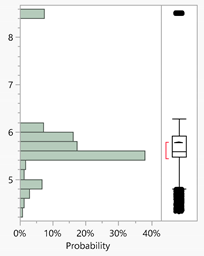 | 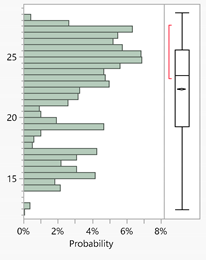 | ||
| Statisticshighlights | Mean | 5,938 | 5,774 | 22,331 |
| Standard deviation | 0,527 | 0,843 | 4,044 | |
| Standard error of the mean | 0,008 | 0,005 | 0,026 | |
| Mean above 95% | 5,954 | 5,785 | 22,383 | |
| Mean below 95% | 5,922 | 5,763 | 22,280 |
| Static Data | Dynamic Data | ||
|---|---|---|---|
| TSS Removal Efficiency (%) | TSS Removal Efficiency (%) | Relative Error | |
| June-20 | 72% | 94% | 0,09% |
| July-20 | 75% | 89% | 0,12% |
| August-20 | 86% | 88% | 0,17% |
Publisher’s Note: MDPI stays neutral with regard to jurisdictional claims in published maps and institutional affiliations. |
© 2021 by the authors. Licensee MDPI, Basel, Switzerland. This article is an open access article distributed under the terms and conditions of the Creative Commons Attribution (CC BY) license (https://creativecommons.org/licenses/by/4.0/).
Share and Cite
di Cicco, M.R.; Masiello, A.; Spagnuolo, A.; Vetromile, C.; Borea, L.; Giannella, G.; Iovinella, M.; Lubritto, C. Real-Time Monitoring and Static Data Analysis to Assess Energetic and Environmental Performances in the Wastewater Sector: A Case Study. Energies 2021, 14, 6948. https://doi.org/10.3390/en14216948
di Cicco MR, Masiello A, Spagnuolo A, Vetromile C, Borea L, Giannella G, Iovinella M, Lubritto C. Real-Time Monitoring and Static Data Analysis to Assess Energetic and Environmental Performances in the Wastewater Sector: A Case Study. Energies. 2021; 14(21):6948. https://doi.org/10.3390/en14216948
Chicago/Turabian Styledi Cicco, Maria Rosa, Antonio Masiello, Antonio Spagnuolo, Carmela Vetromile, Laura Borea, Giuseppe Giannella, Manuela Iovinella, and Carmine Lubritto. 2021. "Real-Time Monitoring and Static Data Analysis to Assess Energetic and Environmental Performances in the Wastewater Sector: A Case Study" Energies 14, no. 21: 6948. https://doi.org/10.3390/en14216948
APA Styledi Cicco, M. R., Masiello, A., Spagnuolo, A., Vetromile, C., Borea, L., Giannella, G., Iovinella, M., & Lubritto, C. (2021). Real-Time Monitoring and Static Data Analysis to Assess Energetic and Environmental Performances in the Wastewater Sector: A Case Study. Energies, 14(21), 6948. https://doi.org/10.3390/en14216948








